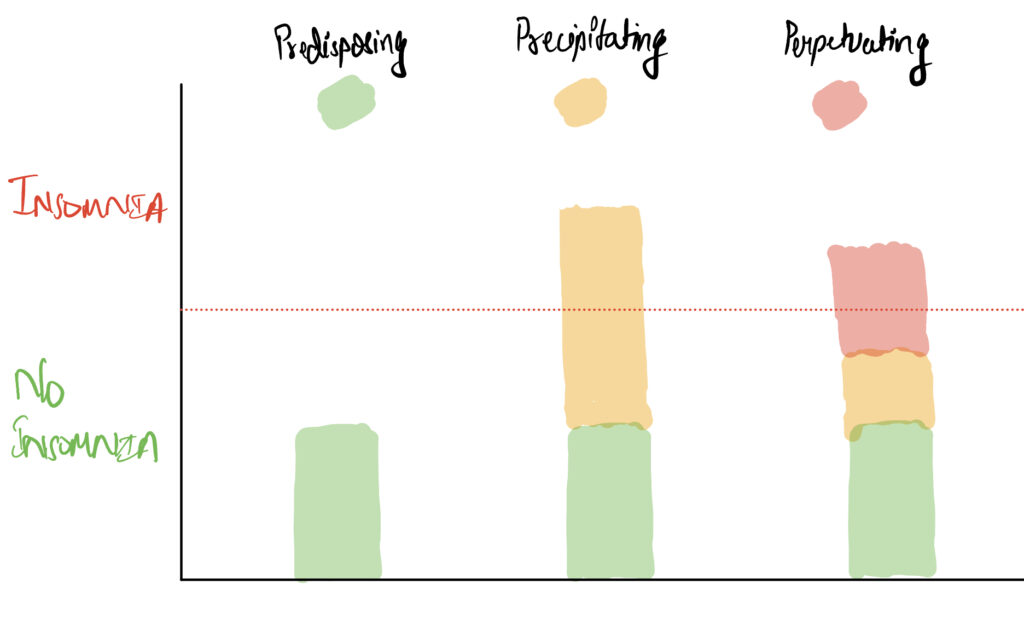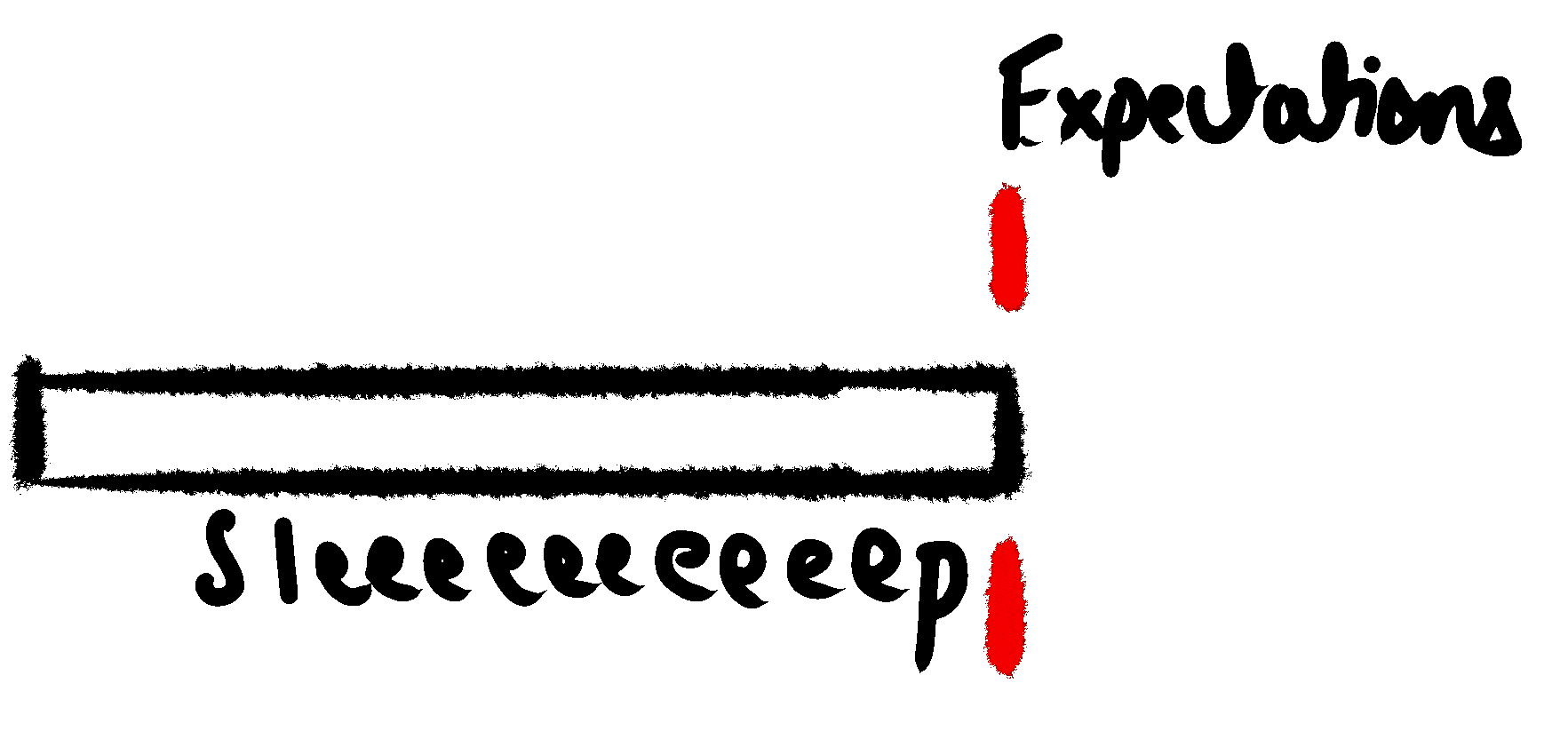Introduction
knowing what causes insomnia could not only protect you from getting insomnia. It could also help you manage your exam stress and various other performance anxieties.
The short answer to what causes insomnia is the excessive importance given to sleep. Sounds counterintuitive, doesn’t it? Let me break it down.
We’ve all had sleepless nights at some point in our life, be it before an important exam or during an illness. We’ve all had it. What happens next is what truly separates insomniacs. Most people are fortunate enough to go back to their routine after the stressful event has subsided. However, some aren’t as fortunate and continue having sleepless nights even after the stressful event has passed. Why does this happen?
In this blog, we will explore the causes of insomnia & how this knowledge could be applied to treat various other performance-related anxieties.
Spielman’s 3P model of insomnia
Insomnia has several different models explaining its origin. But the most accepted model is the 3P model of insomnia.
Three P’s include:
- Predisposing factors
- Precipitating factors
- Perpetuating factors

First, let me briefly talk about predisposing and precipitating factors. We’re going to be discussing perpetuating factors in detail later.
Predisposing factors are the inherent risk factors that make a person more prone to develop insomnia. These could include things like having a more anxious personality, age, and gender.
Precipitating factors are stressful events that are usually quite sudden, and they lead you to develop that first night of sleeplessness. It could be an exam the next morning, losing your job, the death of a loved one, illness etc.
Perpetuating factors
There’s nothing that can usually be done about predisposing & precipitating factors. You can’t change who you are easily neither can you escape all the curve balls that life throws at you. What separates people who’ve had their first night of insomnia from people who’ve had hundreds of nights of insomnia are the perpetuating factors. This will be our main topic of discussion. The reason why perpetuating factors are more important is that they can be treated. Controlled. These perpetuating factors are beneficial in the short term, but self-sabotaging in the long term.
There are 3 main components of perpetuating factors:
- Unrealistic expectations about sleep:
I should be sleeping for 8-10 hours minimum to function properly - Being unable to sleep:
This is usually temporary but we assume it to be permanent. It can include, trying to sleep in the night after just having woken up from a nap or if under undue stress. No one can sleep then but due to the unrealistic expectation of getting more sleep, insomniacs feel as though they’ve lost the ability to sleep - Anxiety:
The mismatch between our expectations & our actual ability to sleep gives room for the cloud of anxiety to seed in. The anxiety further eats up our ability to sleep & raises expectations which causes a further increase in anxiety. This is the vicious cycle that powers insomnia.

Anxiety
Certain thoughts & behaviours further worsen the anxiety. They include:
- Black & white thinking:
Example: Either we slept perfectly or we didn’t sleep at all.
Whereas in reality, most things have 500 shades of grey. They’re never black, they’re never white. Our black & white thoughts are nothing but a misrepresentation of reality. - Overplanning about sleep:
Example: I will sleep exactly at 10:05 PM.
If you’re creating a plan. You are also creating a possibility of failing to achieve that plan. The more specific the plan is, the easier it becomes to fail at it. - Catastrophising:
Example:
if I don’t sleep tonight, I won’t perform well at my job tomorrow.
If I won’t perform well at my job tomorrow, I won’t finish the project.
If I won’t finish the project, I will be fired.
And finally,
If I don’t sleep tonight -> I will be fired
There are lots of ifs and buts that come in between. But that’s never taken into consideration. Another misrepresentation of reality. - High pressure:
Almost any of these factors lead to the creation of high pressure around sleep. This leads to worsening anxiety. - Trying too hard:
Example: An insomniac gets into bed early & gets out of bed late in an attempt to give themselves “more opportunity to sleep”.
More opportunity to sleep doesn’t translate into more sleep. To the contrary, It only leads to more anxiety as the percentage of time spent sleeping to the time in bed becomes low. - Over-analysis:
Example: If I had slept earlier yesterday, I would’ve been easily able to sleep; Only If I exercise, would I be able to sleep.
Sleeping is not rocket science, keep it simple. - Receiving negative feedback:
Example: looking at the clock while trying to sleep.
Negative feedback makes us more aware of what we’re doing. This adds to our anxiety while sleeping. - Assuming negative effects:
Example: A teacher feeling incapable of teaching properly after a sleepless night.
Assuming you won’t be able to function properly without evidence further adds to the pressure & anxiety which leads to worsening insomnia - Using the easy way out:
Example: Takins naps to catch up on sleep
Surprisingly it’s quite easy for an insomniac to nap than to sleep at night. Although this does benefit them in the short run, it is quite harmful in the long run. Napping prevents them from sleeping during the night.

Habituation
When this vicious cycle has bore roots for a long time, we form connections between our bed & negative emotions like anxiety & stress. Ultimately, what is supposed to be relaxing starts making us anxious. Our bed becomes a battlefield. The more we wrestle for sleep the less of it we get. How could anyone sleep if they are in fight or flight mode?
Reversing the perpetuating factors
The good news? Perpetuating factors are reversible, regardless of the duration of insomnia you have had. You need to look out for the perpetuating factors and counter them with the following appropriate strategies:
1. Grey thoughts
It is thinking that accurately represents reality.
Example: If you have slept for 3 hours in reality. You shouldn’t think that you’ve not slept at all. That would be a black thought. Instead, your thoughts should be, I have not slept great but it’s not too bad either.
2. De-Catastrophising
From “If I don’t sleep, I will lose my job” to “If I don’t sleep, my chances of losing the job will probably increase by 0.5%, which isn’t much and I shouldn’t be too worried about it.”
De-catastrophising also uses a healthy dose of reality to bring our anxiety in check.
3. Behavioural experiments:
Challenge your negative assumptions with evidence.
If you think your performance after a sleepless night will drastically reduce. Why don’t you prove it to yourself by experimenting?
Compare your performance after your bad night’s sleep & good night’s sleep. Use objective measurements.
I can assure you the difference won’t be much.
4. Lower your expectations
By lowering expectations, you lower the pressure & anxiety about sleep. Making it much easier to fall asleep.
If you target, say, 30 minutes of sleep. It is easy to achieve. It takes off all the pressure on you, letting you sleep for more than 30 minutes. It is much harder to fail.
5. Make peace with the worst-case scenario
Being okay with the worst-case scenario lessens your anxiety. This counterintuitively makes the worst-case scenario much less likely to occur.
Example: What if I lose my job? I could easily find another job. No need to stress out.
6. Under hyping or Being nonchalant
Instead of overhyping the situation, under hype it.
Example: Even if I don’t sleep today, I’m still going to be doing just fine tomorrow.
7. Recognise & wait for natural cues
Instead of trying to sleep when you can’t sleep, try sleeping when you’re sleepy.
Insomniacs usually confuse tiredness with sleepiness. They’re different things.
Example: Try hitting the bed only when you feel sleepy. Not a moment before. You’ll find that you have slept in no time.
8. Expect failure
Expecting failures reduces expectations.
Example: Expect a few days of sleeplessness in between. Take it easy after you’ve failed to sleep. Weren’t you already expecting to not sleep for a few days in between?
9. Relaxation techniques
Relaxation techniques take your mind off of these unhelpful thoughts.
It is best used in conjunction with the above methods. You need to tackle the unhelpful thoughts directly.
10. Seeing an opportunity instead of a threat
A change in attitude can change your anxiety.
Example: If you consider insomnia as a superpower that adds more hours to your days. Imagine how far ahead you’d be of everyone else.
11. Creating a broad plan instead of a specific one
By creating a broad plan, you increase the chances of it being successful.
Example: Instead of planning to sleep exactly at 10:05 PM, make a plan that involves a range of time, such as 10:00 PM – 11:00 PM. Giving you flexibility and making it less likely to fail
12. Not trying too hard
Sleep will come to you. You don’t have to run behind it.
Example: Don’t try sleeping when you can’t sleep. Get out of bed if you aren’t able to fall asleep within 10-15 mins of trying. Only try sleeping when you feel sleepy.
The bottom line
If you care too much about sleeping well -> You don’t sleep well
If you don’t care too much about sleeping well -> You sleep well (Provided you follow the right advice)
Insomnia and other performance anxieties
Insomnia is merely a type of performance anxiety. In my opinion, this 3P model can be applied to almost any other performance anxieties as well. Including:
- Exam anxiety
- Foreign language speaking anxiety (FLSA)
- Non-organic Erectile dysfunction
- Chronic non-organic pain
- GIT conditions: Irritable bowel syndrome, non-organic chronic constipation
I will leave it to you, for now, to extrapolate this information, from insomnia to the above-mentioned conditions.
Let us know what you think are the 3Ps for exam anxiety.
Nisaab: The line that separates rich & poor
What is Nisaab?How is Nisaab calculated?Nisaab according to silverNisaab according to goldGold or silver?Significance of…
Simplifying Zakat for the millennials: The 2 question checklist
Looking for someone to answer your questions about which of your wealth is Zakatable? Read…





This was useful!!! Thankyou!
Thank you for reading. I’m glad it was of help to you.
In deed the Article by Dr.Mohamed Saeed is interesting and eye opener for a common person like me. I wish him for such a good article of common interest.
I expect your articles on health more frequently to enlightened for leading healthy life style.
It’s a pleasure to be of help. I feel it’s very much the need of the hour.
Thanks alot for sharing about this.
No worries. Let me know if you have any suggestions.